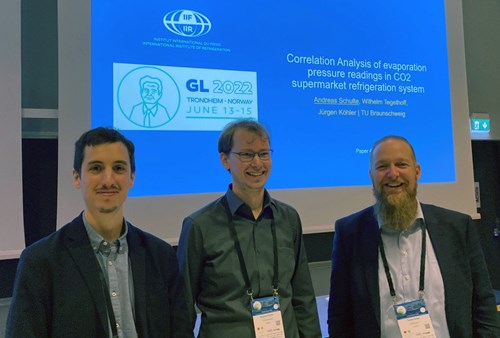
Digital Twins at GL2022
The project Digital Twins for Large-Scale Heat Pumps and Refrigeration Systems contributed to this year's Gustav Lorentzen conference GL2022 with three presentations which provided an insight into the latest developments and results of the project.
The Gustav Lorentzen conference is a biennial event, which since the beginning in 1994 has aimed at contributing to the acceleration of solutions based on natural working fluids for applications within the area of refrigeration, air conditioning, heat pumps, and heat engines. The conference presents and discusses the latest research results and the most recent progress in the area of these technologies. The focus of the GL2022 conference was The Natural Choices by 2030, and the three presentations focusing on the Digital Twins project were given in connection with a session on Operation and System Control (R8).
The first presentation was given by Torben Green from Danfoss, who gave an introduction to the low charge detection method for supermarket refrigeration systems which has been developed and applied in the project. Detection of low refrigeration charge is important to ensure food safety and avoid excessive energy consumption in a refrigeration system, and according to Torben Green, low charge detection in a supermarket refrigeration system can be achieved by utilizing data from the control system by creating a baseline model of the system dynamics. The project shows how a baseline model can be used to identify a low refrigerant charge in a supermarket refrigeration system, and the applied method uses fault detection techniques to detect a significant change in the refrigeration charge. One of the benefits of the method is that it can provide early detection of low refrigeration charge before the refrigeration charge becomes critically low so that the desired temperature can be maintained in the display cabinets. Moreover, the method has been validated using data from two different supermarkets which both have experienced low charge situations.
Next, José Joaquín Aguilera Prado from DTU went on to talk about the integration of dynamic model and classification algorithms for fault detection and diagnosis in a vapour compression system. The Digital Twins project has aimed at developing a framework for fault detection and diagnosis in vapour compression systems by means of machine learning and data obtained from dynamic simulation models, and three different faults, namely refrigerant leakage, reduced condenser water flow rate, and condenser fouling, have been induced in an experimental chiller and a dynamic simulation model. In this case, the simulated operation of the chiller was used to train machine learning methods designed for classification tasks to identify potential faulty and fault-free operation of the physical chiller. The results show that the proposed framework allowed them to correctly identify 94 % of the periods where the experimental chiller was affected by faults. This was estimated to improve the performance of the chiller by approximately 4 %. Overall, the study is an indication of the possibility to integrate model-based and data-driven approaches in the context of digital twins to identify faults in vapour compression systems.
Andreas Schulte from TU Braunschweig closed the session with a presentation on a correlation analysis of evaporation pressure readings in CO2 supermarket refrigeration systems, where he gave an insight into a new way of identifying the structural layout of a supermarket as well as faults in the supermarket. In this connection, the correlation matrix of the evaporation pressure readings was evaluated, and the members of the individual pressure levels were identified by grouping the strongly correlated pressure readings. A hierarchical clustering algorithm was used to make this analysis, and the results show that faults in the system can be detected by checking if the number of identified pressure levels matches the number of expected pressure levels. During the presentation, Andreas Schulte showed and elaborated on two identified examples of faults.
The development of the methods and models are based on data provided from different demonstration cases. Here, you can read more about the different cases.

José Joaquín Aguilera Prado (left), Andreas Schulte, and Torben Green presenting the latest
developments and results of the Digital Twins project at the GL2022 conference in Trondheim, Norway.
If you have questions about the three presentations, please contact the presenters directly.